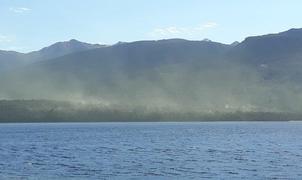DOC plans largest ever predator control programme
08 April 2019, 3:20 AM
 Beech pollen clouds visibly emanating out of Fiordland National Park on Lake Te Anau last spring. Pollen clouds generally indicate a beech mast, or seeding, will follow in the autumn.
Beech pollen clouds visibly emanating out of Fiordland National Park on Lake Te Anau last spring. Pollen clouds generally indicate a beech mast, or seeding, will follow in the autumn.Fiordland and Mt Aspiring National Parks, along with the Catlins are among eight sites that have been listed as priority locations for DOC's "largest ever" predator control programme for 2019/2010 at a cost of $38 million.
Previously known as "Battle for our Birds", DOC’s Tiakina Ngā Manu predator control programme uses the aerially applied 1080 poison and large-scale trapping to protect native birds, bats, frogs, lizards and giant land snails at important conservation sites across the country.
The programme announced today includes more than 66,000ha of trapping with the remainder of more than 900,000ha for aerial 1080 operations
Department of Conservation monitoring indicates New Zealand's forests will be experiencing the biggest beech mast in 40 years this autumn.
Conservation Minister Eugenie Sage said today that results from extensive seed sampling from across the country in February and March pointed to exceptionally heavy seed loads in South Island forests.
A beech mast is a period of heavy seeding. While it provides a bonanza of food for native species, it also fuels rodent and stoat plagues that pose a threat to native birds and other wildlife.
The programme is aimed at suppressing rats, stoats, and possums over more than one million hectares, or 12% of conservation land.
"This is a step up from the previous largest programme of 840,000ha in 2016 and 600,000ha in 2014 and 2017 when there were significant but smaller mast events," Ms Sage said.
Responding to the increased threat from introduced predators during such a big mast year was critical if New Zealand was to retain its unique native species, she said.
"If we don’t act, we could lose populations of bird species like our tree-hole nesting kākāriki/orange-fronted parakeet and mohua, and bats, which are so vulnerable to rat plagues."
The work is targeted to sustain the most vulnerable populations of kiwi, kākā, kōkako, kea, whio/blue duck, mohua/yellowhead, kākāriki/orange-fronted parakeet, rock wren/tuke, long and short tailed bats/pekapeka, native frogs and Powelliphanta snails.
The other priority sites for predator control are Kahurangi, Abel Tasman, Arthur’s Pass, Westland, and Whirinaki.
DOC’s seed sampling programme involved snipping branches by helicopter from over 8000 beech and rimu trees at nearly 200 sites across the North and South Islands and counting more than three million seed pods from 43,000 samples.
More than 1000 tussock plants were also monitored at 63 sites. The estimate of seed-fall this autumn informs predator control planning.
DOC says aerially applied 1080 is the only tool currently available that can effectively knock down rodents over large areas before they reach plague levels after a beech mast. Numerous studies show that it protects vulnerable wildlife and allows birds to produce more chicks to sustain and build their populations.
While most sites have been confirmed and are at an advanced stage of planning, DOC says predator control operations will only proceed at mast sites from May this year if rodents reach levels that pose a threat to wildlife.
The Department has been consulting with iwi partners, regional councils and other pest control agencies, community groups and neighbouring landowners in recent months as part of its planning.